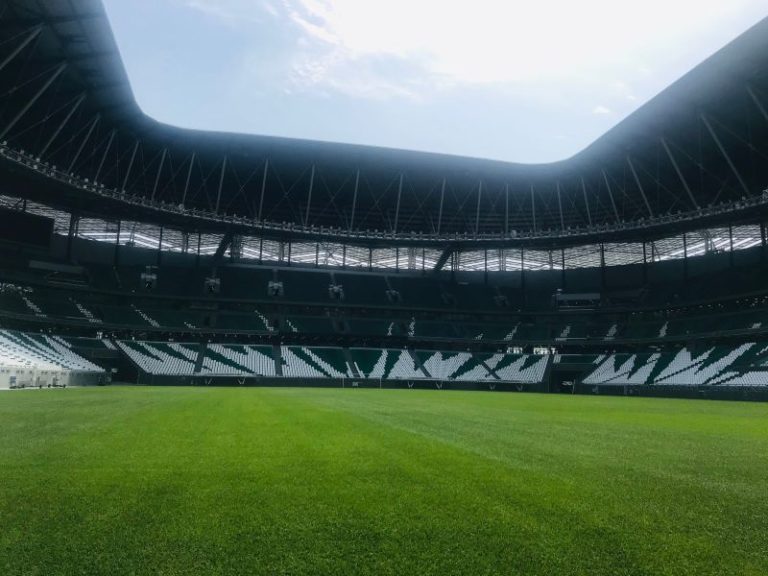For the 2022 FIFA World Cup in Qatar, each of the eight stadiums and all 41 training sites will feature the same turfgrass variety: Platinum TE Paspalum turfgrass. To ensure genetic purity and the highest quality, the Platinum TE Paspalum being utilized is licensed and certified plant material from global turfgrass supplier Atlas Turf International. Platinum TE Paspalum was chosen for the FIFA World Cup venues following extensive testing by Aspire Sports Turf (AST) of Qatar and international sports turf consulting firm STRI. SportsField Management magazine recently interviewed John Holmes, president, Atlas Turf International, about the FIFA World Cup fields and the process of preparing the venues amid the challenging climate and growing conditions of the Middle East.
SportsField Management (SFM): Can you provide some insight into the overall process and timeline of your involvement with the 2022 FIFA World Cup in Qatar, and the planning that has gone into establishing the best and safest playing surfaces for this event?
Holmes: The initial research into the field turf began in 2012 with Platinum TE Paspalum being planted on a practice field at the Aspire Zone soccer facility in Doha. In 2014, UK-based STRI began trialing multiple turf species, including paspalum, zoysia, and bermuda. The trials simulated the various growing challenges in Qatar. The trials included shade tolerance, wear tolerance, establishment, and recovery from injury. After three years of trials, the results showed that, overwhelmingly, Platinum TE Paspalum was best suited for the challenges of the location and the exceptional expectations for World Cup-quality turf performance.
SFM: All of the stadiums and training sites for the 2022 FIFA World Cup will feature Platinum TE Paspalum turfgrass. Has the process been pretty consistent at each of the sites, or are there any unique challenges you have run into with specific venues (or with regard to just the sheer number of venues being established/managed)?
Holmes: The goal of the AST team that is managing all of the pitches is to have each practice pitch and each stadium play the same. Having the same turf on each pitch allows the turf managers to have similar agronomic plans for each venue, and provides teams and players with continuity over the course of the competition. The turf managers at each pitch take daily measurements to ensure that each pitch will play the same. Daily measurements include firmness of the pitch, soil moisture, tensile strength, and ball roll. Additionally, the heights of cut on each field are consistent.
SFM: What are the biggest challenges not only with turfgrass establishment, but also maintaining consistent high-level quality and overall turfgrass performance in Qatar?
Holmes: Qatar is located on the west coast of the Persian Gulf. The summer temperatures can reach 130 degrees during the day. Water quality can also be a challenge.
In the stadiums, the biggest challenge is the shade created by the design. Platinum TE performs well in reduced sunlight, light quality, and light duration situations. Paspalum requires a shorter duration of exposure to light to maintain growth and store carbohydrates from photosynthesis. Because of their design, many of the stadiums in Qatar prohibit long hours of sun exposure on the fields.
Throughout the gulf region, water quality is a challenge. Many countries started out using desalinated water to irrigate turf and landscape. Over the years, as populations began to grow, the cost of using desalinated water has become cost prohibitive. The high cost forced most municipalities to use treated sewage effluent (TSE) water. TSE water is typically high in salts and other elements. Platinum TE, and paspalum in general, grow better than zoysia and bermuda when irrigated with TSE, because the paspalum plant is able to absorb chlorides and other elements when irrigated with water at toxic levels.
SFM: What is the structure/setup in terms of the management of these fields leading up to, and during, the World Cup, and how are event organizers ensuring consistent field quality across all venues?
Holmes: The AST turf team consists of industry leaders from all over the world. They have been in Qatar for several years, building up to FIFA 2022. Each field manager knows all of the nuances of the pitch they maintain. Having the same turf in all venues makes it easier to create consistency in all of the stadiums and practice pitches despite each location having its own set of unique challenges. Additionally, the Aspire team is equipped with the latest technology to diagnose field conditions on site, as well as in their own laboratories within the country.
This is probably the first time in the history of the World Cup where a country has been this prepared for the event. The Arab Cup in 2021 was a dry run for the country – not only for field conditions but for logistics, housing and fan involvement. Another unique item is that all matches will be played in one city, making it easier for consistency between the turf management team.
To our knowledge, this is also the first time each and every World Cup competition venue features the same turfgrass variety.
[Note: In addition to supplying Platinum TE Paspalum, Atlas Turf collaborated with seed partner Pure Seed of Oregon to provide ryegrass for overseeding many of the World Cup stadium fields and pitches.]

